While this may sound very basic to some users, others may find it useful. I received a couple of emails in the last few months asking me to prepare a basic tutorial on how to create shortcuts. So in this post, we will see how to create a desktop shortcut in Windows 11/10, for your favorite application, program, website, etc, and place it on your Desktop or any other folder, for easy access.
How to create Desktop Shortcut in Windows 11/10
To create Desktop Shortcut in Windows 11/10, do the following:
- Right-click on its .exe file and select Show more options
- Click on Send To > Desktop (Create shortcut)
- Alternatively, right-click on the desktop and select New > Shortcut
- Enter the path of the program executable file
- Click on Next and give it a name
- Click on Finish and a desktop shortcut will be created
- Change its icon if you wish now.
The simplest way to create a desktop shortcut for your favorite program is to right-click on its .exe file and select Show more options.
Next click on Send To > Desktop (Create shortcut). You will see that its shortcut has been created on your Windows desktop.
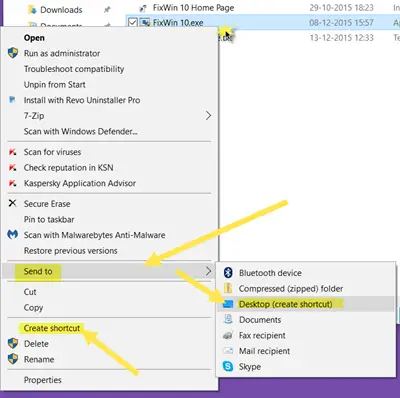
If you instead select Create shortcut, its shortcut will be created in the same location. You can then drag and drop into your desired folder location.
There is another way, and that is by right-clicking on your desktop and then selecting New > Shortcut. You will see the following box open.
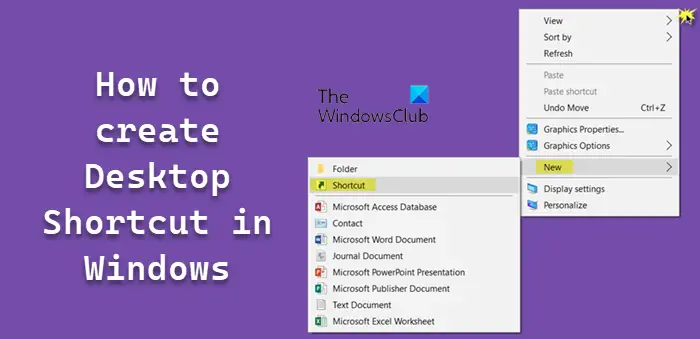
You have to enter the path of the program executable file, for which you want to create the shortcut.
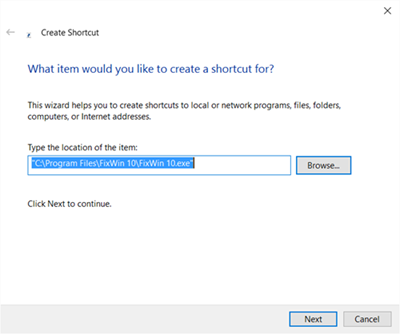
If you know the path enter it, else click on the Browse button and browse to the .exe file and select it.
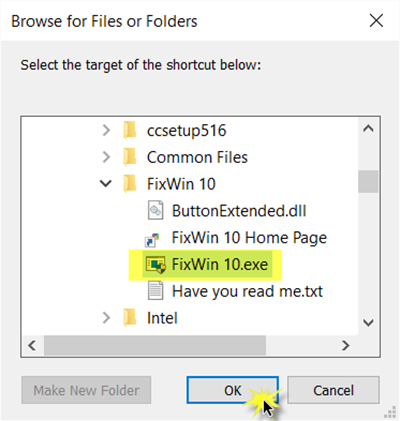
As an example, I have taken FixWin, a free tool that helps you fix Windows problems with a click. Once you have selected it, click on OK.
Now click on Next to open the following window. You may keep the same name or modify it.
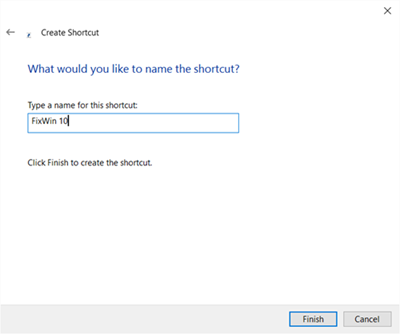
Clicking on Finish will create a desktop shortcut. But you will notice that it takes the default icon.
To give the shortcut a proper icon, right-click on it and select Properties.

When the Properties box opens, click on the Change icon button.
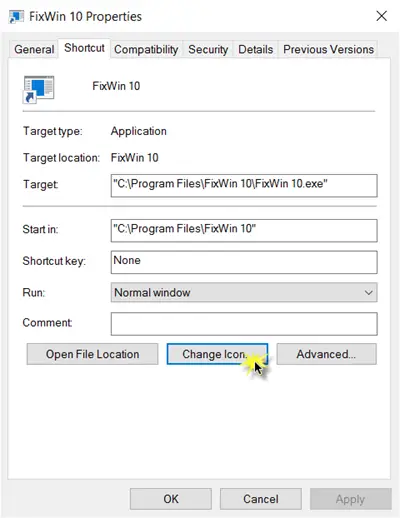
The following box will open. You may select one of the system icons or you may click on the Browse button and browse to the folder where you may your personal stock of .ico files.
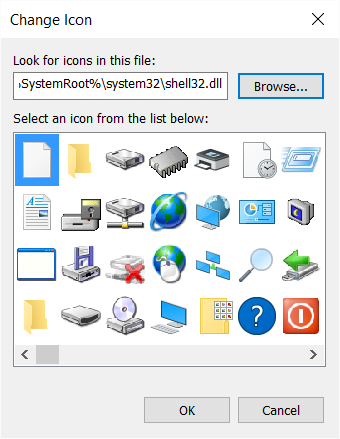
Select the icon you want and click on Apply. Your shortcut will get the cool icon, you wanted.
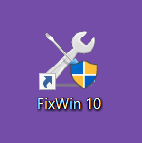
Incidentally, if you wish to, you can always cut-paste and move this shortcut and place it in any other folder of your choice.
If you do not like it, you can remove the Shortcut to text & the Shortcut Arrow using a registry tweak or our freeware Ultimate Windows Tweaker, which is available for Windows 11/10.
TIP: This is how you can create desktop shortcuts for Windows UWP apps.
There are other ways to create desktop shortcuts too!
Create Desktop Shortcut using Right-Click
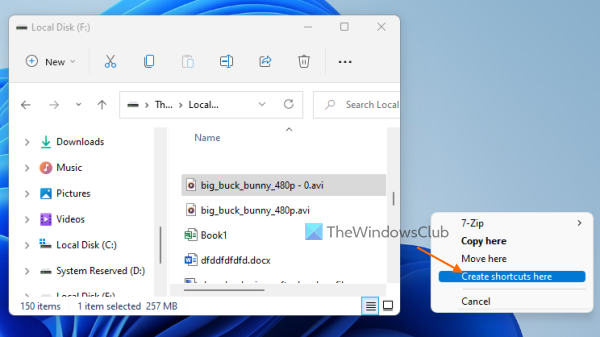
Creating a desktop shortcut using right-click on Windows 11/10 is one of the easiest and quickest options. You can create a desktop shortcut for any file, folder, application or program, etc. The steps are:
- Open File Explorer using Win+E hotkey
- Access a hard drive where your files and folders are present
- Press and hold right-click on a file/folder
- Drag the selected item and drop it on desktop
- A context menu will open on the desktop
- Click on Create shortcuts here option in that menu
It will instantly create a desktop shortcut for that particular item.
Create Desktop Shortcut using the Start menu of Windows 11/10
If you want to create a shortcut link or desktop shortcut for a Microsoft Store app or some other program or application using the Start menu of Windows 11/10, then follow these steps:
- Press the Win key or Start button to open the Start menu
- Access the All apps section in the Start menu
- Press and hold the left mouse button on an item
- Drag that item and drop it to the desktop. In other words, drag an item to the desktop and release the left mouse button.
Create Desktop Shortcut for a program or file using the Alt key and Left mouse button
The steps to create a desktop shortcut for a program, file, or folder using the Alt key and left mouse button on Windows 11/10 are as follows:
- Press Win+E hotkey to open the File Explorer
- Select a program or file using the left mouse button. You can select multiple items if you want. A separate shortcut will be created for those
- Press and hold the Alt key
- Drag the selected item(s) to the desktop using the left mouse button
- Release the left mouse button.
How do you add shortcuts to your desktop in Windows 10?
There are multiple ways to add shortcuts to your desktop in Windows 10 and Windows 11 OS. You can create shortcuts for files, third-party programs, Microsoft Store apps, etc., using the following ways:
- The Start menu
- Using the right-click or right mouse button on File Explorer
- Alt key and left mouse button
- Desktop shortcut wizard.
All these options with step-by-step instructions are added in this post above.
How do I create a shortcut to a file on my desktop?
If you want to create a shortcut for an executable file (say EXE), a folder, some application, or some other item, you can use Send to context menu for that file and select the Desktop (create shortcut) option. Or else, you can also use right-click option or the Alt key plus the left mouse button for the same. All these options for creating a shortcut to a file on the desktop are explained in this post above.
Using this procedure you can also:
- Create Shutdown, Restart, Log Off, Suspend Shortcuts
- Create Slide To Shutdown shortcut
- Create Website Shortcuts
- Create a desktop shortcut to Switch User Accounts
- Create a Clear Clipboard shortcut
- Create a shortcut for Evernote Tag and Notebook.
These posts will help you if you need to create other shortcuts:
- Create a single desktop shortcut to open multiple web pages
- Create a Remote Desktop Connection shortcut.
- Create Desktop Shortcut to Disable, Enable Windows Firewall
- Create Desktop shortcuts to open various Settings in Windows
- Automatically create shortcuts to removable media on Windows desktop.
You can also use our freeware Handy Shortcuts to create many other shortcuts. Our Create-A-Shortcut Tool will let you create shortcuts anywhere on your computer easily. Do take a look at them. Both work on Windows 11 too.